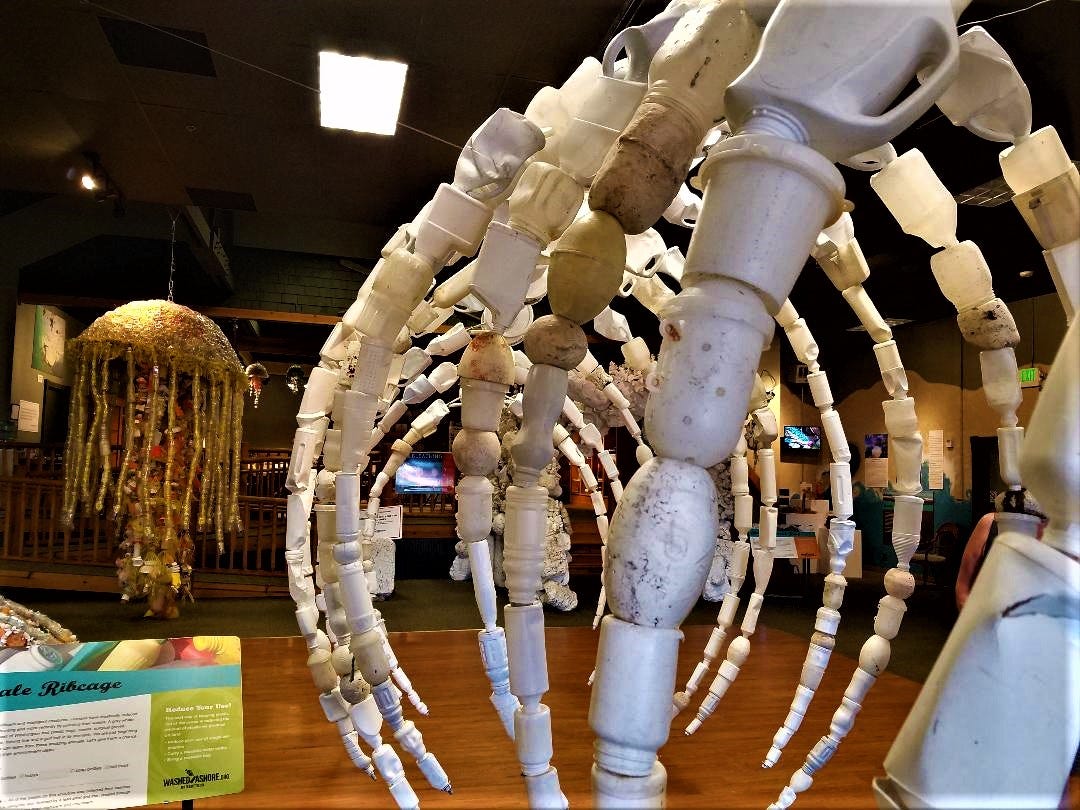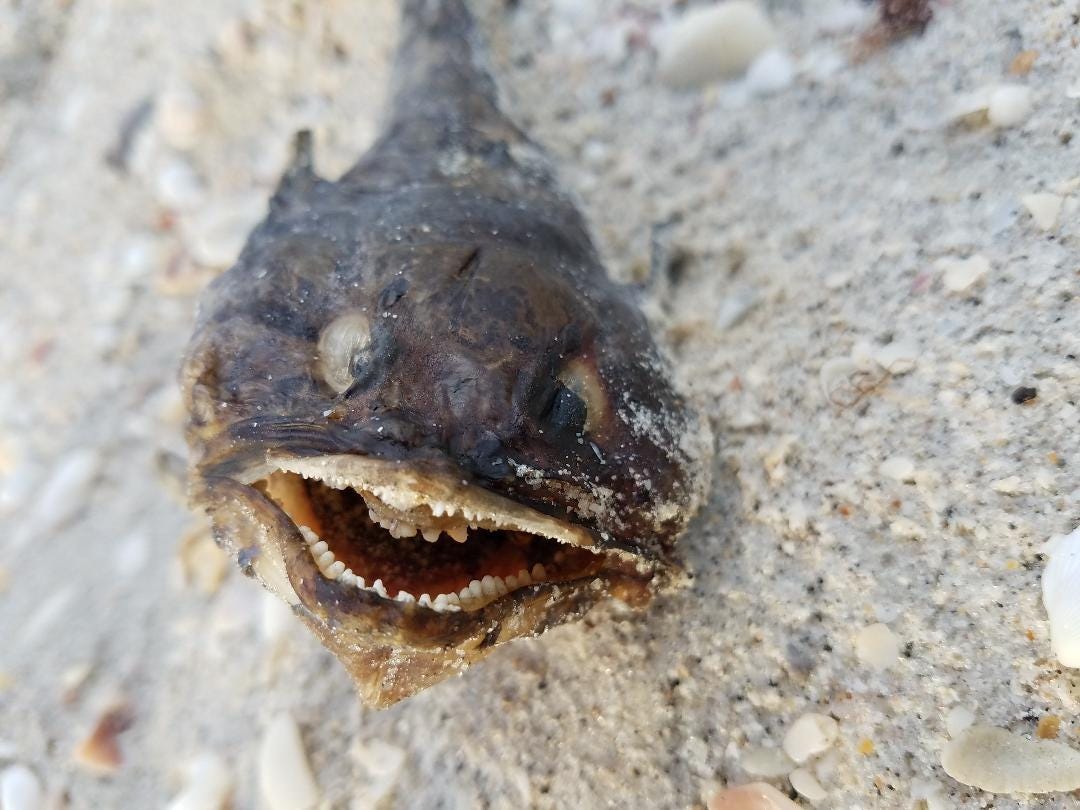Resurrecting dead marine life through the architecture of manmade ocean garbage, at Washed Ashore Gallery in Bandon, Oregon.
Four years before his death in 1999, I spent a few moments on the phone with one of the 20th-century’s acclaimed architects, George Hellmuth. His worldwide projects ran the gamut, in form and functionality: the Moscone Convention Center in San Francisco, the World Trade Center in Taipei, the American embassy in El Salvador, King Saud University in Saudi Arabia, even a federal prison in Marion, Ill. He didn’t hesitate when asked about the source of his inspiration.
“Architecture, if you study it, is cast in iron. It’s a set style, and you can trace its development. From its Egyptian origins it grew and influenced Greece, which influenced Rome, which influenced the Renaissance, and so forth.
“But,” he added, “the architecture of the Maya culture grew independently, like a civilization you might find on Mars or Venus. It was totally apart from all that, which is what’s so fascinating about it. Imagine, what goes on in a young man’s mind.”
Hellmuth’s teenaged mind was activated by Carnegie Institution Mayanologist Sylvanus Morley. He followed from a distance as Morley led expeditions into the Mesoamerican tropics to explore pre-Columbian pyramids. Toiling between two world wars, hunting for clues about origins, Morley’s shovels and picks led him to a novel conclusion — the Maya were led by astronomers and mystic priests who had learned to live in harmony with nature and each other. And maybe the spectacular monuments they left behind were possibilities for what might still lie ahead.
The allure of lost civilizations is as ancient as storytelling itself, most notably popularized in 360 B.C. by Plato in his praise of Greek democracy. Seeded by Poseidon, Plato’s Atlantis, west of Gibraltar, was an allegorical naval power that laid siege to Athens. Athenians crushed the invasion, and the entire continental kingdom subsequently sank beneath the waves of the Atlantic Ocean.
Where did Plato’s brainstorm come from?
Some devotees of the Atlantis story scoured archaeological sites for material remnants of the lore; others wondered where Plato got his ideas. Given the copious spreads of ancient sunken cities (e.g., Pavlopetri, Greece, 1,000 B.C., Yonaguni Jima, Japan, 10,000 B.C., Atlit-Yam, Israel, 5,000 years old), there was no shortage of candidates. And the quest for descendants expanded. By the 19th-century, some theories were promoting Maya architecture as artifacts from a colonial Atlantean age.
Anyway, as George Hellmuth moved on to create more conventional legacies, Morley’s aspirations for the beatific Maya star-gazers collapsed with mounting evidence of internecine warfare, atrocities and self-induced ecological catastrophe. And we have science to thank for slaying centuries of mythmaking and dashing our romantic illusions.
Yet, given the expanding scope of the UFO problem, science may yet force us to take a second look at the legends. Two significant political developments dropped last month: 1) the Senate proposed the establishment of an Unidentified Aerospace-Undersea Phenomena Joint Program Office, and 2) the Under Secretary of Defense for Intelligence and Security announced a bid to mollify congressional snoops with another new acronym, AARO, or All-domain Anomaly Resolution Office. Both are semantic and substantive concessions to the growing suspicion that non-human intelligence may enjoy sovereignty of our oceans as well as our atmosphere.
As we know, that sinking feeling didn’t begin in 12/17 with the NY Times report of Navy fighter pilot encounters with “Tic Tac” UFOs over the Pacific. Nor, as we also know, has the U.S. cornered the market on comeuppance from these bizarre maritime affairs.
In 2009, ex-Soviet rear admiral Yury Beketov told Russia Today about detecting “material objects” in the Bermuda Triangle region that “defied the laws of physics” by moving at underwater speeds of 230 knots. He got a big amen from retired naval officer Vladimir Azhazha, who asserted that “Fifty percent of UFO encounters are connected with oceans, 15 (percent) more with lakes.” Azhazha recalled a disaster at Lake Baikal, Earth’s largest and deepest body of freshwater, when three of seven divers who reported humanoids in “silvery suits” died in pursuit.
In Wonders in the Sky (2009), researchers Jacques Vallee and Chris Aubeck issued a chronological history going back to 1460 B.C. Lebanon, a narrative that also made room for UFO interactions above the world’s oceans. From the late 15-century logs of Christopher Columbus and Pedro Cabal (the first European to set foot in present-day Brazil), to a vessel approached in 1848 by two “rolling haystacks on fire” in the Arabian Sea, the descriptions adhere to the logic of their times.
‘Turning its bow to the north without sails’
Among the most detailed is a Feb. 8, 1672, account from one Captain Isaac Guiton, off Cherbourg, France. Guiton describes a 15-foot long, mid-day “star” that buzzed his ship and split in two, “each with two lights and the mizzen and their large sails folded, both sailing to the south.” But the display was just beginning: “… Another ship formed in the middle, seemingly bigger than the others, all black, and turning its bow to the north without any sails, yet equipped with its masts and ropes, as if resting at anchor. They seemed to us to take over half an hour. After which, they vanished to the south without leaving any trace . . .”
Tale as old as time, right. Well, last month, in the Journal of Cosmology, physicist Hal Puthoff tried to make our longstanding confusion over UFOs even more complicated. The piece was titled “Ultraterrestrial Models,” and it isn’t a new idea. But it’s worth reconsidering as our research-target area will now officially include what 70 percent of this planet has always been about – water.
Beyond the ETs, interdimensional specters and time travelers, Puthoff’s ultraterrestrial hypothesis builds on the premise that the volume and frequency of UFO sightings “is so ubiquitous as to argue against the simple model of an occasionally-visiting extraterrestrial explorer.” But try to wrap your head around this alternative-suspect scenario.
Imagine an “isolated pre-Diluvial high-tech society . . . existing alongside us in distinct stealth.” And what if, despite their ridiculous technology, these hypothesized “co-located denizens of our planet” were “nonetheless being subject to a certain level of co-dependence” on humans. What if their stealth was rooted in “an overarching fear of exploitation, even annihilation, due to vulnerabilities . . . or fear of assimilation.”
What if their technology couldn’t stave off mortality? What if their furtive interactions with human beings were about securing “genetic diversity for a relatively inbred, local, isolated society on the wane and suffering from a potentially debilitating genetic syndrome”? What if, “via subterfuge and disinformation,” the ultraterrestrials “stealthily injected … emphasis on the ET theme as misdirection to prevent exposure of terrestrial habitation”?
Puthoff supposes the consequences of confirming the ultraterrestrial option could be “more dire” for humanity than ET visitation, “considering that they had been here, ‘amongst us,’ perhaps in very personal ways.” On the other hand, nothing prohibits both possibilities from acting simultaneously. But the only reason I’d want to be alive a hundred years from now is to see which one made the most money.
To go where we are not
The emerging emphasis on chasing the evidence into our seas and deep lakes makes perfect sense to MUFON’s chief photo/video analyst Marc Dantonio. He once had an encounter aboard a U.S. nuclear submarine – a story he’s repeated numerous times – that made him re-evaluate everything. He was convinced of this much: “I believe that if aliens are here, they’re gonna go where we are not, and that is the deep ocean. But that still gives them access to us.”
Astronomer, entrepreneur, inventor and consultant for History, TLC and Discovery programming, Dantonio worked with the late Hollywood special effects wizard Douglas Trumbull on developing equipment designed to troll UFO hotspots. He’s also mapped out a solar-powered platform that might host deep-water surveillance gear, which could be tethered, under water, to a sea anchor and recharged internally using wave action. But the actual sensors themselves aren’t there yet.
“It would be very different from looking up into the sky (for UFOs) because many of those frequencies we’re looking for get stopped by the water,” says Dantonio, who has contacted NASA about joining its newly related research efforts. “We have sonar, which is sound, and sound travels very well underwater. But many of these (USOs) are soundless, so there has to be something else. You’d need something to look at long frequencies, and those things are under development.”
Dantonio has held security clearances while working military contracts. And as a result – he won’t say which sub, or what year – he found himself joining a routine exercise in the Atlantic when an unforgettable encounter rocked his world. Dantonio was zoning out and trying to settle his stomach when he was jolted by a sonar operator making an animated announcement: “Fastmover! Fastmover!” “I thought we were gonna get hit by a torpedo, I thought I was gonna die out there,” Dantonio recalls.
The young sailor told the sub’s executive officer the target was moving at Marvel Superhero velocities of “several hundred knots” before disappearing from the screen. The XO told sonar to “log it and dog it,” then told Dantonio to put a cork in it.
Several years later, while working on another Navy project, Dantonio says he summoned the nerve to ask a senior officer about the fastmover issue. The guy said he couldn’t talk about “the program,” sorry.
“So I’m driving back from Washington that day, all the way (home) to Connecticut,” Dantonio remembers, “and I’m thinking, wow, the U.S. navy knows they’re out there, and they can’t do a darned thing about it, something out there that is nowhere within our technological level.”
From the Why Do They Hate Us? files: A postcard from the sprawling, year-long red tide fish massacre, Nokomis Beach, southwest Florida, 2018
So: Imagine a non-human intelligence, co-located denizens of our planet, commanding mind-bending technology yet living in secretive existential dread of an egocentric plastic-puking surface species burning itself alive with fossil fuels. Imagine tossing the ultraterrestrial variable into STEM-track curricula. Imagine, as George Hellmuth mused nearly a century ago, what goes on in a young man’s mind.






"The only reason I’d want to be alive a hundred years from now is to see which one made the most money." LOLOLOLOLOL ...
Hmm. Try to convince non-intelligent humans about non-human intelligence. Nope.